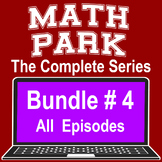COMPARING AND ORDERING FRACTIONS - MATH PARK - VIDEO/EASEL LESSON #303
- Streaming Video(cannot be downloaded)
- Supporting Information
- Easel Activity
- Easel Assessment
Also included in
- Would you like to find new ways of giving your students a good foundation with fraction and decimal concepts? Give the Emmy Award-winning MATH PARK a try! These NO-PREP VIDEO LESSONS and follow-up EASEL ACTIVITIES and ASSESSMENTS can give your students the differentiated help they need. Here’s what’Price $15.00Original Price $20.00Save $5.00
- Would you like to find new ways of giving your students a good foundation with number sense, multiplication, and fraction & decimal concepts? Give the Emmy Award-winning MATH PARK a try! These NO-PREP VIDEO LESSONS and follow-up EASEL ACTIVITIES and ASSESSMENTS can give your students the differePrice $45.00Original Price $57.50Save $12.50
Description
Would you like to find new ways of giving your students a good foundation with fraction concepts? Give the Emmy Award-winning MATH PARK a try! This NO-PREP VIDEO LESSON and follow-up EASEL ACTIVITIES can give your students the differentiated help they need.
The concepts and skills taught in MATH PARK 303 include:
- Comparing fractions with the same numerator and different denominators
- Using fraction bar models makes it easier to compare fractions
- Using fraction bar models for putting fractions in order from least to greatest
- When the numerator and denominator are the same, the fraction is actually one whole.
Here’s what’s included:
- A fifteen-minute teaching VIDEO LESSON
- A printable TEACHER GUIDE for making the video lesson more effective
- Four interactive EASEL ACTIVITIES to reinforce the concepts/skills
- An automatically graded EASEL ASSESSMENT for teacher feedback
Here’s what satisfied teachers and parents are saying:
“Math Park is extraordinary! My students love it and actively participate in this interactive math resource. It’s always a treat for them when an episode is shown. Even my most reluctant math learners are engaged. Math Park has a wonderful way of making even the most daunting math concepts accessible to all – in an enjoyable and painless way.”
Natali Escobedo, Teacher
Los Angeles, California
“My son has been diagnosed with ADHD and he has a really hard time focusing and staying on task. But the imaginative approach of Math Park really got his attention. Math Park’s positive attitude and energy helped him to keep focused.”
Joanna Rivera, Parent
Los Angeles, California
I hope you will give MATH PARK a try in your classroom or at home!
I would appreciate your REVIEW/RATING of this MATH PARK lesson.
Please follow me at: https://www.teacherspayteachers.com/Store/Lucky-Cat-Productions
Thanks!
Robert
Email: luckycatproductions@gmail.com



